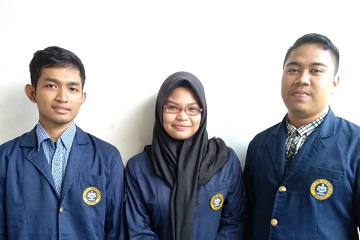IPB Students Utilize Cocoa Skin to Prevent Fruit Rottenness

After harvesting, fruits will gradually decline in quality until it decomposes. To maintain the shelf life and quality can be done by the coating technique. Three students of the Department of Biochemistry, Faculty of Mathematics and Natural Sciences, Bogor Agricultural University (IPB), Eva Aolia Zuhra, Jembar Pambudi and Ari Fahreza Mantovani, under the supervision of Dr. Laksmi Ambarsari, MS invented coating agent (or wrapping agent) from nanoparticles of cocoa leather pectin waste.
"The fruit that has been harvested is actually still experiencing the process of metabolism. In the fruit there are pores. When the pores are covered with a coating, carbon dioxide (CO2) from the fruit cannot escape and Oxygen (O2) cannot enter so that the metabolism and fruit decay will be inhibited, "Jembar said.
This team deliberately chose cocoa skin because it is considered underutilized. In the process of, they take advantage of mesocarp of cocoa skin which pectin is being taken. "So far, cocoa skin is considered as waste and rarely used, but it turns out contains a lot of pectin and potential as a source of pectin," he said.
Before being used as a coating agent, the pectin material was first used as a nanoparticle. The nanoparticle-sized pectin has advantages over the previous one. "We first process the pectin into nanoparticles by ionic gasification method. With the size of the nanoparticles, its physicochemical ability of pectin will be increased because the purpose of this pectin utilization is as a coating (wrapping). By turning it into the nanoparticle, its pores will be closed and coated compactly and its shape will be not visible as it is transparent,” he said.
The shape of this coating agent is powder. In the application, the powder is dissolved in water with a certain dose. The fruits to be coated are dipped into a solution that has been mixed with pectin powder or by spraying. In addition to maintaining the quality of fruit, pectin also has antimicrobial properties against bacteria and fungi.
"Its principle is that the fruit after the coating will look more bright and shiny and it will be difficult to overgrown by fungi and other pathogens. So far, we have successfully until the make the nanoparticles and in the process of its optimization. We will also find the right concentration in the application, "he said.
With this idea, the team managed to pass the Student Creativity Program in the field of Research Eksakta (PKMPE) held by the Ministry of Research, Technology and Higher Education (Kemenristekdikti) RI. They cite the proposal as "Coating Agent of Zincpectin Nanoparticles from Cacao Skin Waste as an Inhibition of Malang Apples Maturation". They hope that this coating agent can be used in various fruits. (flw)



